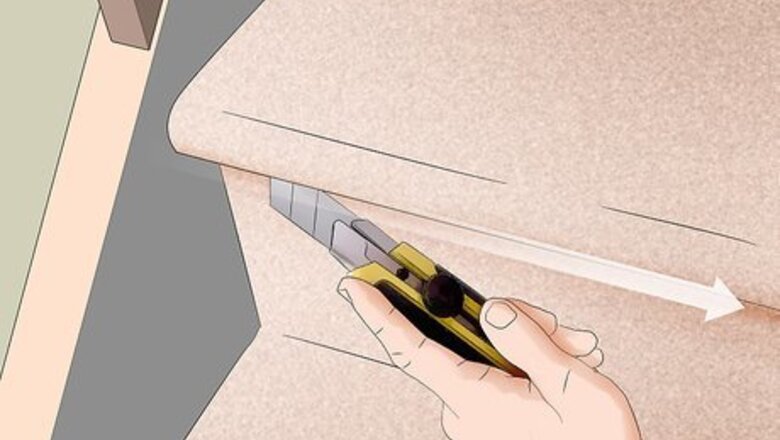
views
Pulling up the Carpet
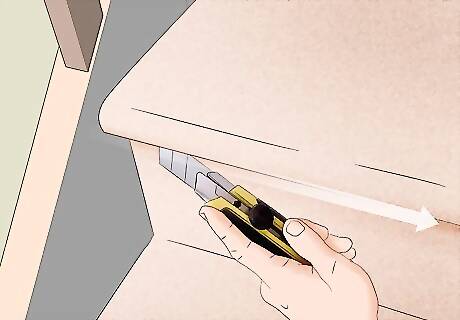
Cut the carpet with a utility knife under the lip of the top step. Use a new, sharp blade on your utility knife. Slice the carpet in a straight, horizontal line underneath the lip of the top step. Make a shallow cut so that you don’t cut into the riser, which is the vertical part of the step. An X-acto knife or a razor may work as a substitute for a utility knife, though a utility knife is the best option.
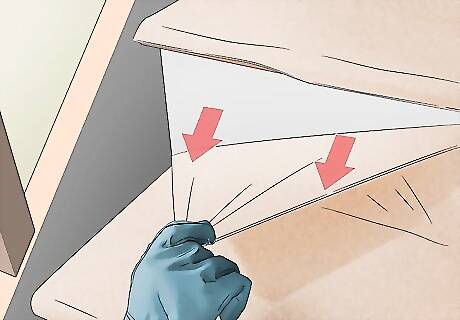
Tear up the carpet, making cuts as needed. Wear leather gloves while you tear up the carpet to protect your hands from carpet staples. Start from the top of the stairs and pull the carpet firmly as you walk down the stairs. Many carpets will peel off in one long strip, but if your carpet gets stuck, make another slice with your utility knife. It’s a good idea to wear hard-soled shoes, so you don’t pierce your feet with staples and nails embedded in the carpet.
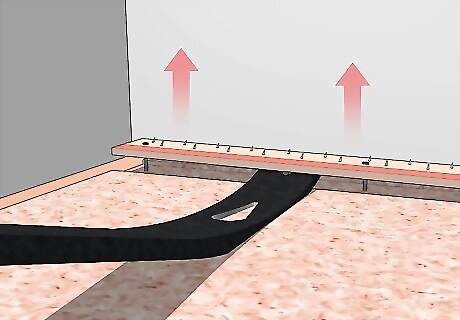
Pry off all the tack strips with a flat pry bar. The tack strips are pieces of wood stuck through with nails, and they’ll be at the corners where one step ends and the next begins. Pry the tack strips off your stairs with a flat pry bar. Wear safety goggles to protect your eyes from any wood or nails that may come flying when you pry the tack strips loose. If you don’t have a pry bar, you can use the back of a hammer or a flat head screwdriver. However, since pry bars are useful for many steps of replacing your stair treads, it’s worth it to invest in one.
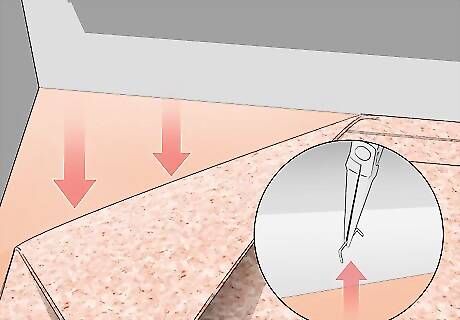
Pull out the padding and remove the carpet staples with pliers. Underneath the carpet, there is still more fabric, which is the padding on the stairs. Make sure you are still wearing your leather gloves. When you pull up the padding, tufts of it will remain behind on the stairs, because they are attached to the carpet staples. Wriggle your pliers underneath each staple and yank it out. There are a lot of staples in the stairs, so be prepared to spend an hour or more pulling them out. Check under the lip for staples, too.
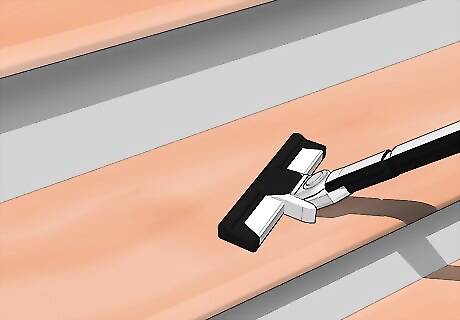
Clean up with a broom and a vacuum. There’s going to be a lot of dust, dirt, and grime on your stairs that made it through the carpeting over the years. Sweep it all up using a broom and dustpan and throw it away. Then, go over the stairs again with a vacuum. If you’re sensitive to dust, you may want to wear a dust mask during this step. Even though you’re going to discard the old treads, it will make working with them much easier if they’re clean.
Removing the Old Treads
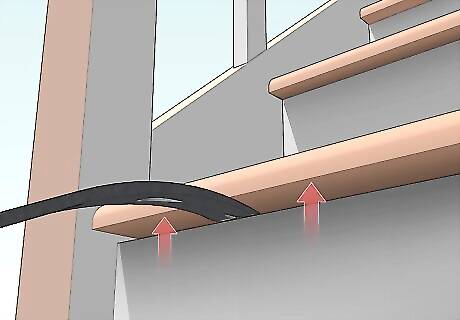
Pry up the tread enough to fit a blade underneath. Start at the second step from the top since the top step is really more of a landing than a stair. Wiggle a flat crowbar into the line between the tread (the horizontal part of the step) and the riser (the vertical part of the step). Push down on the crowbar to lever the tread up. You won’t be able to completely pry up the tread, because it has lots of nails holding it in place. If the step has a wooden molding that sits underneath the top lip of the tread, pry up the molding with a crowbar and remove it completely.
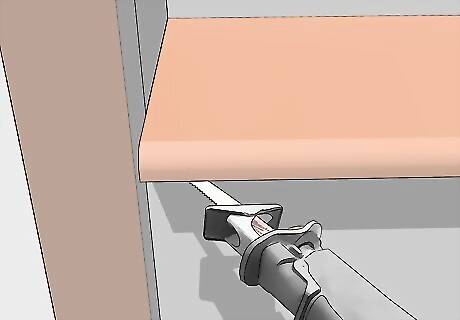
Slice through the nails with a reciprocating saw. Wear safety goggles and leather gloves to protect yourself. Put a long nail-cutting blade on your reciprocating saw. Slide the saw underneath the pried-up stair tread, and cut through the nails with the saw. Make sure not to cut through the wood that forms the stringer, which is the wooden frame along the sides of the steps.

Remove the tread completely with a crowbar. Slide your crowbar underneath the tread and lever it up. You may have to pry it up all along its length and jiggle it to get it loose. If you can’t pry it off, you may not have sliced through all the nails, so run your saw through again.
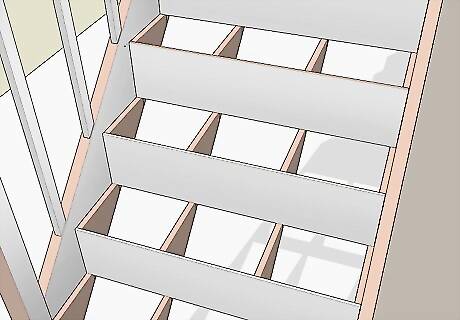
Repeat the process on each stair. Continue working until you've removed the tread from every stair in the same manner. It's best to work from the top of the stairs down to the bottom so you don't get stuck on the landing.
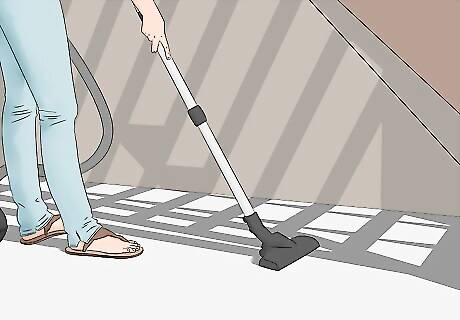
Vacuum or sweep up the dirt under the stairs. This may be your only opportunity to clean underneath your stairs. There will likely be a lot of dust and dirt underneath, so vacuum it up or sweep it with a broom and dustpan. This will make the process of installing the new treads much more pleasant, since you won’t have to be breathing in dust the whole time.
Measuring and Cutting the New Treads
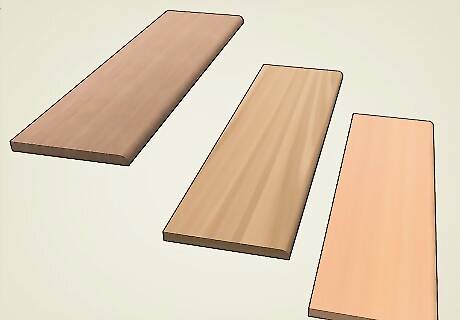
Buy stair treads in your preferred wood. Common types of wood include pine and oak. You can buy the treads either finished or unfinished. Buying unfinished treads will save you money, while buying finished treads will save you time. If you have hardwood floors, you might want to get a matching wood for your stairs, though some people like to have contrasting stairs. You can buy stair treads at home supply stores or online.
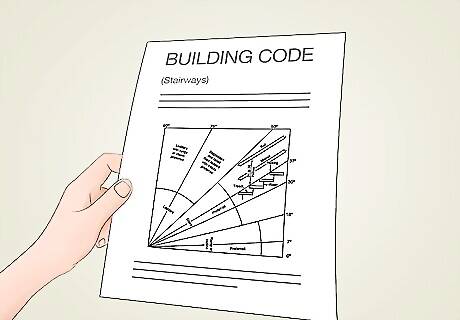
Find out your local building code for stair measurements. Building codes vary a bit by country and state. As one example, in California, the risers need to be no taller than 7.75 inches (19.7 cm), the treads have to be at least 10 inches (25 cm) deep, and the nosing must be between .75 to 1.25 inches (1.9 to 3.2 cm). Many building codes call for no more than a 0.375 inches (0.95 cm) variation in the riser heights.
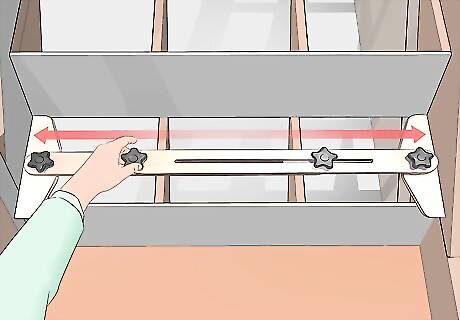
Use a stair gauge to find the dimensions for each new tread. Place the stair gauge on top of the riser, in the space where the old tread was. Loosen the screws on top of the stair gauge so that you can extend the wings fully against the skirtboard. Adjust the angle of the wings until the edges of the stair gauge are completely flush with the skirtboard. Tighten the screws to hold the measurement in place. Each tread is slightly different, so measure each one individually.
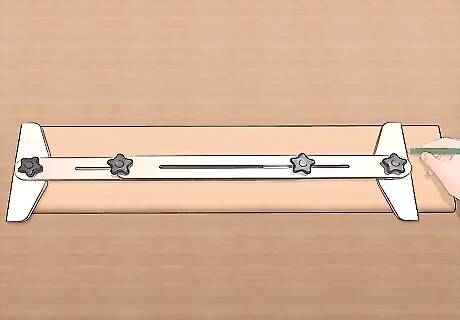
Lay the stair gauge over the new tread and trace the measurements. When you lift up the stair gauge from the step, the angles and lengths will stay in place if you’ve properly tightened the screws. Lay the stair gauge on top of the piece of wood that will be the new tread and trace the edges with a pencil. Label the underside of the tread for the bottom step with a 1, the second step with a 2, and so on. That way you will easily be able to tell which tread goes where. Double check your measurements– it’s easy to fix a mark, but not a cut.
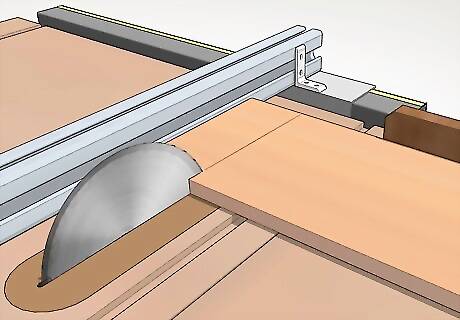
Use a table saw to rip the tread to the right length. Adjust the fence so that the distance from the fence to the blade is the length you need to cut the board. Set a taper guide to the same angle as you need to cut. Set the blade so that it rises higher than the thickness of the wood by at least 0.125 to 0.25 inches (0.32 to 0.64 cm). Turn on the blade, hold the wood against the fence (or taper guide), and run the board through the saw at a steady pace. Wear leather gloves and eye protection whenever you’re using the table saw, and don’t wear any loose or dangling clothes. Never get your hand close to the blade – there should be at least 6 inches (15 cm) between your hand and the blade at all times. Make sure the blade guard is down and that you know where the stop button is. Only use a table saw if it has a blade cover or a riving knife to prevent kickback. Turn off the saw when you’re done with the cut.
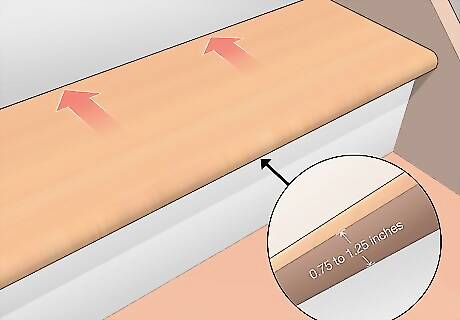
Place the tread on the step and mark it to the right depth. Put the tread onto the step and measure how much the tread sticks out from the riser with a measuring tape. Depending on your local building code, the nosing requirements (how much it sticks out over the riser) may be different, though in the US it’s often 0.75 to 1.25 inches (1.9 to 3.2 cm). If the tread sticks out further than it should, mark the end of the tread with how much you want to take off. Measure twice, cut once, is a good rule for woodworking, so double check your measurements.
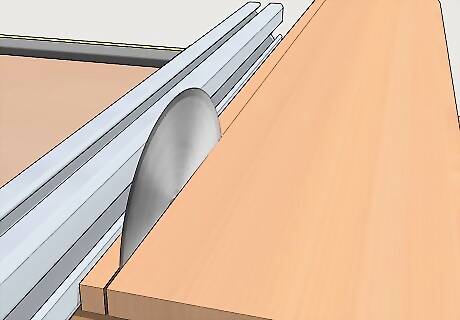
Rip the tread to the right depth with the table saw. If it’s already the right depth, you don’t need to do anything, but if you need to shorten the depth, use the table saw again. Take all the precautions that you did the first time you used the saw. For this rip cut, you don’t need to use a taper guide, because the cut isn’t at an angle. Turn on the blade, hold the wood against the fence, and run the board through the saw at a steady pace. Remember to keep your hands far away from the blade at all times.
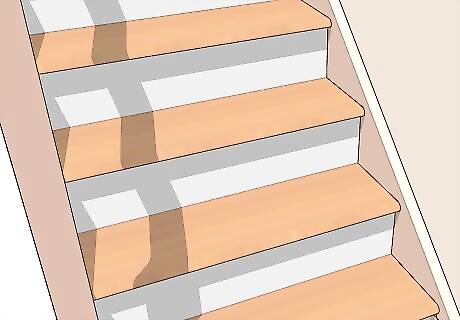
Repeat the process for each step. Measure the space where the new tread will go with the stair gauge. Trace that measurement onto your new tread and cut the tread with a table saw. Measure and cut the depth of the tread. Each step will be slightly different, so measure and mark each board separately.
Installing and Finishing the New Treads
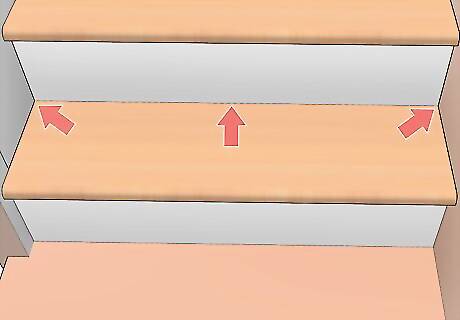
Check the fit of the treads and make necessary adjustments. Before you attach the treads, double check that they are the right dimensions by putting them all down on the steps. Bang the treads into place with a rubber mallet if they don't slide into place easily. Make sure each tread fits well with the side walls. If it doesn’t fit, carefully measure, mark, and cut again to get the right dimensions.
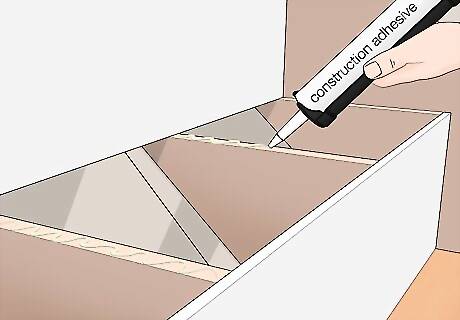
Glue the tread to the bottom step with construction adhesive. Squeeze the glue onto the parts of the stair that the tread will sit on top of. It’s best to squeeze the glue in a zigzag pattern, rather than a straight line, so that there’s more glue. Press the tread into position on top of the glue. Don’t try to cut costs by using a weaker type of glue, because it won’t hold up. Wipe any glue off the tip of the glue bottle before it dries so that you can easily use it again.

Secure the tread with nails and a nail gun. Put 8d finish nails into your nail gun. Press 2 nails into each side of the step, so that they sink into the stringer (the part of the stairs that goes up either side of the stairs). The nail gun will recess the nails slightly so they won’t be noticeable. Never put your hand over the tip of the nail gun.

Continue working your way up the stairs until you’re done. With each tread, double check the fit, glue the tread, and then nail it into place with the nail gun. Be patient and do each tread as carefully as you did the first one. When the bottom ones are done, you can sit or kneel on them to reach the top steps.
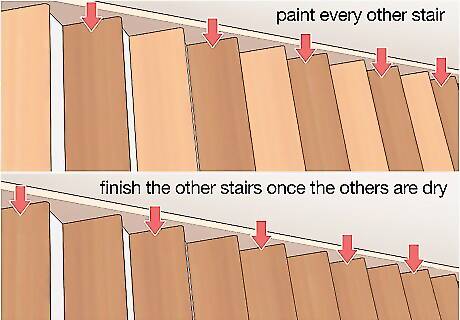
Apply wood finish to the treads if they’re unfinished. Test the finish first on a scrap of wood left behind from your project to make sure you like the color. Then, paint the finish onto the stairs. Paint every other stair if you need to use the stairway in the next few hours. Then, finish the other stairs once the others are dry. That way, you can walk up the stairs using every other stair. Another option is to finish all the stairs at once and avoid using that stairway. Make sure to tell everyone in your household that you just finished the stairs, so they don’t step on it and ruin it.












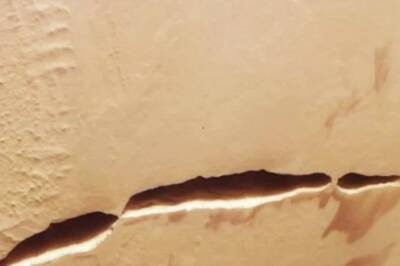





Comments
0 comment